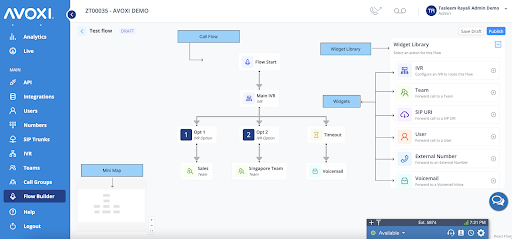What Is Phone Provisioning? How It Works and Why It Matters
Provisioning phones across global teams is rarely straightforward. Between inconsistent setup methods, scattered device settings, and limited visibility, even a basic deployment can turn into a logistical drain. And while phone provisioning is critical for efficiently onboarding users, managing devices, and scaling voice systems, most teams overlook it until something breaks.
As enterprises push for more agile, centralized communications, rethinking the provisioning process isn’t just helpful, it’s necessary.
What is phone provisioning?
At its core, phone provisioning is the process of configuring Voice over Internet Protocol (VoIP) phones—assigning numbers, network settings, and user-specific profiles—so they can connect to a phone system and start handling calls.
While the concept sounds straightforward, provisioning has evolved significantly with the rise of cloud communications and global deployments.
A brief evolution of phone provisioning
Phone provisioning has come a long way, from hands-on setup to API-driven automation:
- Manual setup (pre-2000s): IT teams configured desk phones individually using local interfaces or keypad inputs, which was slow and error-prone.
- Web-based configuration (2000s): Admins started using web interfaces to enter device settings like IP addresses, MAC addresses, and Session Initiation Protocol (SIP) credentials. Slightly faster, but still manual.
- Centralized provisioning servers (2010s): Devices began pulling configuration files from remote servers via provisioning URLs, streamlining large-scale deployments.
- Zero-touch and API-driven automation (today): Modern systems now auto-configure out of the box using DHCP options, APIs, and cloud-based dashboards, making global rollouts faster, safer, and more consistent.
Key terms to know
To better understand modern provisioning workflows, it helps to clarify a few key terms and technologies:
- Provisioning: Configuring a phone or SIP device to work with a service provider’s network or Private Branch Exchange (PBX)
- Direct Inward Dialing (DIDs): Virtual phone numbers assigned to a specific phone or user for direct call routing
- Zero-touch provisioning: Automatic device configuration without manual input, often using a combination of MAC address recognition, DHCP, and pre-built templates
- SIP trunking: The protocol that initiates, maintains, and ends VoIP calls between IP phones, analog telephone adapters (ATA), or softphones
- APIs: Interfaces that allow automated provisioning, number assignment, and configuration syncing with Customer Relationship Management systems (CRMs) or Unified Communications as a Service (UCaaS) platforms
Common provisioning pain points
Despite advancements, many IT teams still face friction points during deployment, such as:
- Inconsistent configurations across phone models (e.g., Yealink, Polycom, Grandstream) due to firmware or template differences
- Manual MAC address entry and network setup that increases deployment time and error risk
- Limited visibility or centralized control when managing phones across regions, provisioning servers, or service providers
Types of phone provisioning
Enterprises have several options for provisioning IP phones, each with its own advantages, limitations, and technical requirements. The right fit depends on your infrastructure, scale, and need for control or flexibility.
- Cloud-based provisioning: Cloud-based provisioning allows IT teams to configure phones remotely using centralized dashboards, automation, and APIs. It supports zero-touch provisioning, simplifies global rollouts, and integrates easily with platforms like CRMs and UCaaS systems.
- On-premises and legacy provisioning: This type of phone provisioning relies on local servers, on-site PBX systems, manual MAC address entry, and device-specific configuration files. While it offers tight control over network and call routing, it’s resource-heavy and difficult to scale across distributed environments.
- Hybrid provisioning approaches: Hybrid provisioning combines on-premises control with the flexibility of cloud tools. It is often used during migrations or in environments that require compliance, failover, or local routing.
How phone provisioning works: Lifecycle, automation, and APIs
From device activation to reassignments and eventual decommissioning, the provisioning process involves multiple steps where automation and integration can dramatically reduce friction.
1. Device recognition and initialization
When an IP phone or an analog telephone adapter connects to the network for the first time, it contacts the provisioning server using DHCP options or DNS records. The server identifies the device by its MAC address and points it to the correct provisioning URL to begin setup.
2. Configuration deployment
The device downloads a configuration file containing SIP credentials, firmware updates, voicemail settings, and phone number assignments. With zero-touch provisioning, this happens automatically, which is ideal for distributed teams and large-scale rollouts.
3. Workflow automation with APIs
Modern provisioning automates the full communication lifecycle. APIs connect provisioning actions—like updating SIP credentials, assigning phone numbers, or rebooting a phone remotely—to other systems in real time.
For instance, AVOXI’s Flow Builder provides a visual, drag-and-drop interface that lets IT teams build intelligent call flows and provisioning logic without writing a single line of code. Admins can route calls to specific teams, forward to external numbers or voicemail, and integrate with CRMs using predefined widgets, all from one dashboard.

4. Ongoing management and updates
Once deployed, phones continue to receive firmware patches, network configuration changes, and security policy updates via the provisioning server. If a user switches locations or roles, admins can instantly push a new setup remotely without physical access to the device.
5. Decommissioning or reassignment
When a device is no longer in use, admins can remotely return it to factory settings using a web interface or API command. They can then remove it from the system or reprovision it for a new user, ensuring license control and device hygiene.
Manual methods: Still in use, but riskier
While some businesses still rely on manual provisioning, this approach is slow, error-prone, and difficult to scale.
Manual entry increases the risk of misconfigurations, missed updates, and inconsistent functionality across devices from manufacturers such as Polycom and Cisco phones. For enterprises managing hundreds of phones, efficient, automated provisioning is essential for ensuring uptime, consistency, and control.
Benefits of phone provisioning
Modern provisioning boosts operational efficiency, scalability, and security. Here’s how:
Streamlined setup and automation
Efficient provisioning reduces the hands-on burden for IT teams by:
- Eliminating manual configuration: Zero-touch provisioning and auto provisioning templates ensure phones arrive fully configured, with no need to enter MAC addresses manually or log into web interfaces.
- Streamlining deployment: DHCP servers, SIP settings, and firmware updates are all pushed automatically from a centralized platform, saving hours of setup time across locations.
- Ensuring consistency: Automation minimizes user error and maintains uniform configuration across all phone models, whether they’re from Yealink, Grandstream, or Cisco.
This streamlined approach means faster onboarding, fewer support tickets, and a more consistent user experience across the organization.
Global flexibility and cost control
As teams become more distributed, provisioning must support global operations without creating complexity. Modern cloud-based systems achieve this by:
- Enabling remote management: IT can onboard users, configure phone numbers, and assign profiles without shipping phones back and forth.
- Centralizing control: Centralized platforms consolidate business phone numbers and service providers into a single, unified interface.
- Reducing costs: Businesses gain greater cost visibility and control by reducing reliance on fragmented systems and one-off vendor relationships.
AVOXI enables global provisioning from a single dashboard, helping IT teams deploy and manage devices across countries without juggling regional vendors or support processes.
Built-in security and compliance
Provisioning is also a frontline control for security and regulatory compliance. Strong provisioning practices deliver protection by:
- Preventing unauthorized access: Devices provisioned via encrypted channels and verified MAC addresses reduce the risk of spoofing or security breaches.
- Enforcing compliance requirements: Centralized management facilitates the enforcement of global compliance standards, the application of firewall rules, and ensures secure call routing through approved PBX systems.
- Blocking fraud: Real-time monitoring, usage controls, and secure configuration practices help prevent toll fraud and maintain policy adherence.
For instance, AVOXI enhances these protections with automated fraud detection, dynamic credit limits, and real-time call detail records, giving IT teams greater control over voice security.
5 signs your provisioning process is holding you back
Even with the right devices and service providers, outdated provisioning can quietly create bottlenecks across your telephony infrastructure. Here are five red flags that signal it’s time to modernize.
1. You’re spending too much time managing voice vendors
Handling multiple voice vendors—each with their own provisioning methods, portals, and ticketing systems—eats into valuable IT resources. Switching between provisioning servers, updating configuration files, and resolving support issues can quickly become unsustainable.
Symptom: Your team spends hours toggling between platforms just to activate a phone or change call routing. Support requests stack up, and provisioning feels like a full-time job.
Solution: Centralize voice provisioning through a cloud platform like AVOXI. Fewer vendors, fewer dashboards, and built-in automation drastically cut down setup time and simplify vendor management.
2. You’re struggling to predict and reduce costs
Inconsistent provisioning methods often lead to unpredictable usage patterns, redundant licenses, and poor control over allocated DIDs or phone numbers. Without automation, scaling up or down becomes a guessing game.
Symptom: You can't track which phones are active, where resources are allocated, or how provisioning affects your monthly costs.
Solution: Automated provisioning and real-time dashboards offer visibility into device usage, licensing, and inventory so you can scale without the financial surprises.
3. It’s becoming increasingly difficult to resolve issues
Manually provisioned phones often lack standardized templates, making troubleshooting harder. A firmware mismatch here, an incorrect SIP credential there, and suddenly, your support team is deep in the weeds.
Symptom: When a device fails, diagnosing the problem takes hours because every phone is configured differently or lacks centralized logs.
Solution: Use structured provisioning templates and version-controlled configurations to maintain consistency. AVOXI’s tools also enable rapid reboots, remote diagnostics, and faster rollbacks.
4. You can’t easily configure, manage, and monitor call flows
Traditional provisioning separates phone setup from call logic. That makes it hard to adapt to evolving business needs, like adding voicemail routing, setting failovers, or updating cloud PBX rules.
Symptom: Changes to call flows require multiple tickets, manual edits, or coordination between departments.
Solution: Use AVOXI’s centralized call routing engine to connect provisioning directly to real-time call management. You can configure routing logic, monitor call activity, and manage number assignments from a single cloud interface, eliminating third-party systems and manual coordination.
5. You lack visibility and have inconsistent data
Without centralized provisioning, you're relying on siloed records, static spreadsheets, or scattered device logs. That leads to outdated or inaccurate network and user data.
Symptom: You don't know which phones are active, where they are, or what network configurations they’re using.
Solution: Modern provisioning platforms maintain a real-time inventory of devices, settings, and users. AVOXI’s voice features give you a single source of truth for all your SIP phones, provisioning events, and number assignments.
Commonly Asked Questions About Phone Provisioning
Phone provisioning is the process of configuring VoIP phones with the necessary settings, such as SIP credentials, firmware, and network details, so they can connect to a phone system and operate correctly.
Streamline your voice management using a truly global provider
A modern phone provisioning strategy, powered by cloud technology, automation, and global reach, helps you:
- Leverage zero-touch provisioning, centralized dashboards, and intelligent workflows for consistent setups worldwide.
- Ensure security and compliance with encrypted provisioning, fraud monitoring, real-time call data, and policy-driven routing.
- Connect seamlessly with UCaaS, CCaaS, AI systems, and CRMs through 40+ plug-and-play integrations and APIs.
AVOXI delivers on all fronts: global coverage in 150+ countries, automated provisioning and compliance tools, and broad integration capabilities, giving you full clarity and control over your voice infrastructure.
See how AVOXI makes phone provisioning faster, smarter, and globally consistent. Schedule a free demo today to experience the difference.
